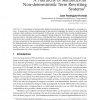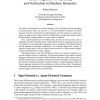338 search results - page 17 / 68 » A Language for Task Orchestration and Its Semantic Propertie... |
83
Voted
AAAI
2006
15 years 1 months ago
2006
Many common web tasks can be automated by algorithms that are able to identify web objects relevant to the user's needs. This paper presents a novel approach to web object id...
137
click to vote
TLDI
2010
ACM
15 years 17 days ago
2010
ACM
Interactive programs, such as GUIs or spreadsheets, often maintain dependency information over dynamically-created networks of objects. That is, each imperative object tracks not ...
106
Voted
FMCO
2004
Springer
15 years 5 months ago
2004
Springer
Abstract. Coordination languages are intended to simplify the development of complex software systems by separating the coordination aspects of an application from its computation ...
88
Voted
FSTTCS
2008
Springer
15 years 1 months ago
2008
Springer
ABSTRACT. Formalisms involving some degree of nondeterminism are frequent in computer science. In particular, various programming or specification languages are based on term rewr...
113
click to vote
EJC
2008
15 years 1 months ago
2008
The notion of a fragment was coined by Montague 1974 to illustrate the formal handling of certain puzzles, such as de dicto/de re, in a truth-conditional semantics for natural lan...


